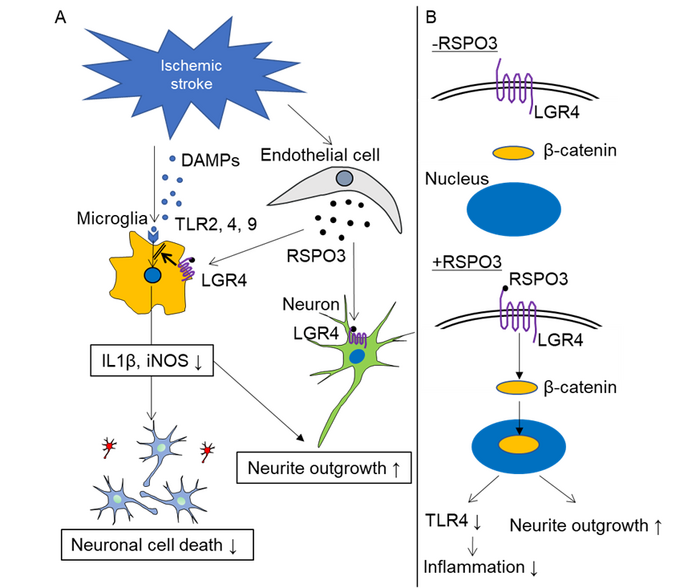Scientists from Osaka University have discovered two proteins, RSPO3 and LGR4, that can trigger a chain of reactions in cells to reduce inflammation in the brain caused by ischemic stroke. These proteins can also stimulate the growth of extensions from neurons, which is important for rebuilding the connections between neurons that are damaged by the stroke. The findings give hope for the development of new treatments to improve patient outcomes.
The lead author of the study, Munehisa Shimamura, explains that previous studies had shown that RSPO3 was helpful in treating inflammation-induced lung injuries. The researchers also knew that RSPO3 could promote neurite outgrowth, a process that encourages the growth of extensions from neurons. Shimamura wondered whether RSPO3 could also help reduce inflammation and promote neurite outgrowth after an ischemic stroke.
The researchers from Osaka University found that RSPO3 and LGR4 proteins are present in the same brain structures and activate each other to stimulate the Wnt pathway. They also identified the specific cells in which these proteins are located in the ischemic brain. RSPO3 was found in endothelial cells, while LGR4 was found in microglia/macrophage cells and neurons.
The researchers wanted to test whether RSPO3 could activate LGR4 by injecting RSPO3 into the brains of mice at 24 and 48 hours after an ischemic stroke.
The researchers found that mice injected with RSPO3 showed fewer sensory and motor deficits compared to mice injected with a control protein, nine days after the stroke. They also found that RSPO3/LGR4 reduced the expression of TLR4, a protein that causes inflammation. Additionally, the expression of pro-inflammatory factors decreased, while signs of neurite outgrowth increased.
The study’s results are exciting because RSPO3 was given to mice one day after the stroke, indicating that it may be beneficial for treating stroke in later stages. The discovery of the RSPO3/LGR4 signaling pathway could be used to develop new therapies for ischemic stroke, and potentially improve patient outcomes.
###
The article, “R-spondin 3/LGR4 axis is a novel inflammatory and neurite outgrowth signaling system in the ischemic brain in mice,” will be published in Stroke at DOI: https://doi.org/10.1161/STROKEAHA.122.041970
About Osaka University
Osaka University was founded in 1931 as one of the seven imperial universities of Japan and is now one of Japan’s leading comprehensive universities with a broad disciplinary spectrum. This strength is coupled with a singular drive for innovation that extends throughout the scientific process, from fundamental research to the creation of applied technology with positive economic impacts. Its commitment to innovation has been recognized in Japan and around the world, being named Japan’s most innovative university in 2015 (Reuters 2015 Top 100) and one of the most innovative institutions in the world in 2017 (Innovative Universities and the Nature Index Innovation 2017). Now, Osaka University is leveraging its role as a Designated National University Corporation selected by the Ministry of Education, Culture, Sports, Science and Technology to contribute to innovation for human welfare, sustainable development of society, and social transformation.
Website: https://resou.osaka-u.ac.jp/en


